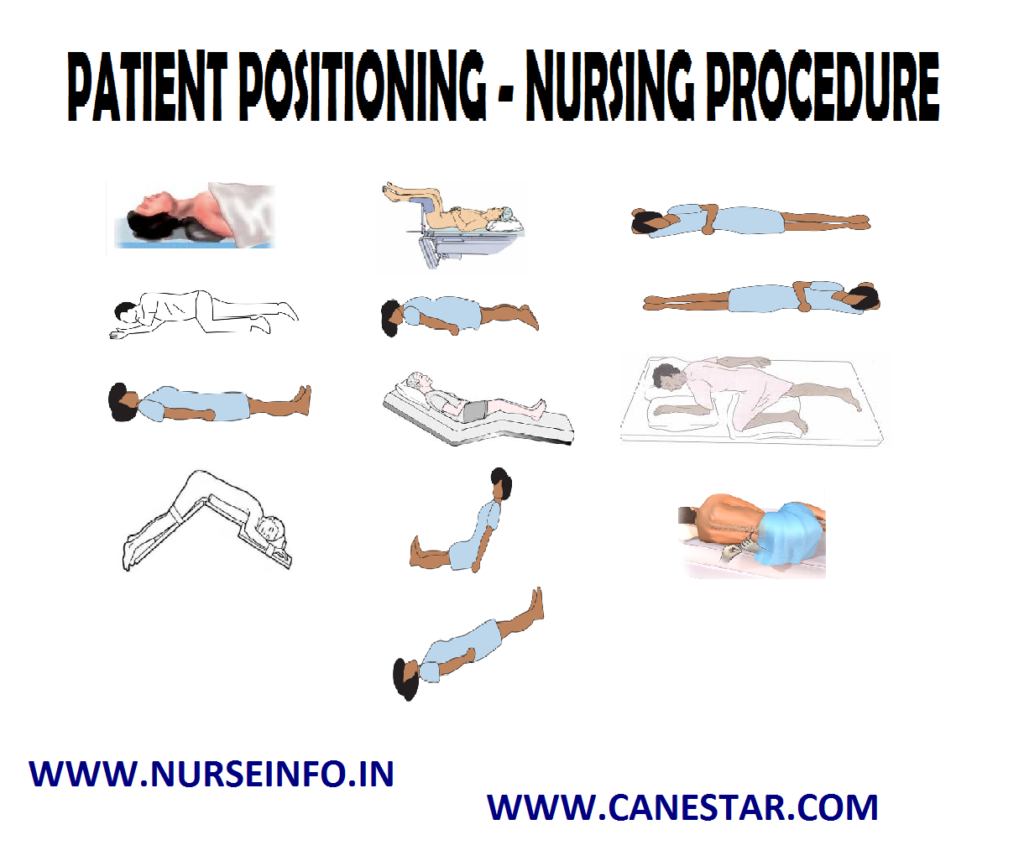PATIENT POSITIONING – Purpose, Principles, Factors Involved, Types, General Instructions, Preliminary Assessment, Equipment and Procedure
Updated 2024
Positioning defined as placing the person in such a way to perform therapeutic interventions to promote the health of an individual.
Positioning defined as placing the person in a proper body alignment for the purpose of preventive, promotive, curative, and rehabilitative aspects of health.
PURPOSE
- To provide comfort to the patient
- To relieve pressure on various parts
- To improve circulation
- To prevent formation of deformity
- To carry out investigations
- To perform surgical and medical investigations
- To prevent pressure sores
- To provide proper body alignment
- To conduct delivery/labor
- To carryout nursing interventions
PRINCIPLES OF POSITIONING
- Systemic and orderly way of doing
- Cooperation between two
- Follow safety measure to prevent accidents
- Active participation
- Using a right technique at right time
FACTORS INVOLVED INN POSITIONING
- Need of an individual
- Self care ability
- Extend of disability
- Nature of disease condition
- Level of consciousness
- Protocol of the hospital
TYPES OF POSITION
- Dorsal position
- Dorsal recumbent position
- Lithotomy position
- Lateral position
- Prone position
- Slim’s position
- Knee-chest position
- Trendelenburg’s position
- Fowler’s position
SUPINE POSITION
Supine position, the patient lies on his back with his head and shoulders are slightly elevated. One pillow is given under the head. His legs should be slightly flexed. A small pillow is placed under his knees.
LATERAL POSITION
Patient lies on left side with legs flexed at thighs. The upper leg is flexed more than the lower. A pillow is kept in front of the abdomen and at the back and one under the upper leg.
PRONE POSITION
A patient lies flat on abdomen. Head turned to sideways. One soft pillow is given under head. An extra pillow is given under the ankles to keep toes from touching the bed.
DORSAL RECOMBENT POSITION
Patient lies on back, knees fully flexed, thighs flexed and externally rotated feet flat on the bed
SEMI-FOWLER’S POSITION
The semi-fowler’s position is the position of a patient who is lying in bed in a supine position with the head of the bed at approximately 30 to 45 degrees.
FOWLER’S POSITION
Fowler’s position is a sitting position in which the head is elevated, at least, a 45 degree angle. Back rest and two pillows are used for the back and head. Fowler’s position the main weight bearing areas of the patient are the heels, sacrum and the posterior aspects of the ileum.
LITHOTOMY POSITION
The patient lies on her back. The legs are separated and thighs are flexed on the abdomen and the legs are on the thighs. The patient’s buttocks are kept the edge of the table and legs are supported by stirrups.
ASSISTING THE PATIENT IN KNEE-CHEST POSITION
A prone position in which the individual rests on the knees and upper part of the chest, assumed for gynecologic or rectal examination. It is also called genupectoral position.
KNEE CHEST POSITION
Patient rests on the knees and the chest. The head is turned to one side with one check on a pillow. A pillow is placed under the chest. The weight is on the chest and knees.
CARDIAC POSITION
The client is propped-up in a sitting position by means of back rest and pillows. Place an over bed table in front with a pillow on it. The client has an aircushion to sit and a small pillow under the knees.
TRENDELENBURG’S POSITION
The patient lies on his back. The patient’s head is low. The foot of the bed is elevated at 45 degree angle. The body is on an inclined place and the legs hang downward over the end of the table.
TYPES OF PATIENTS NEED SPECIAL CARE
- Unconscious patient
- Infant and children
- Hemiplegic and paraplegic position
- Immediate postoperative patients
- Orthopedic patients
- Cardiac patients
GENERAL INSTRUCTIONS
- Maintain good body alignment of the patient at all times
- Support body parts in good alignment by using supportive devices to promote comfort and prevent undue muscle strain
- Avoid prolonged flexion of any one body segment by changing the position at least every two hours
- Reduce the pressure caused by body weight of his or her body or object by changing the position and using protective devices
PRELIMINARY ASSESSSMENT
- Check the patient’s general condition
- Check the physician’s order for any limited movements
- Assess the self-care ability of an individual
- Arrange the comfort devices near the bedside
- Identify the deformed extremity
- Support the immobilize area during positioning
- Identify the rationale before positioning
EQUIPMENT
- Extra man power if needed
- Extra pillows
- Sheets and sheet rolls
- Comfort devices such as back rest, cardiac table, sand bag, etc

PROCEDURE
- Explain the procedure to the patient
- Provide privacy
- Arrange the articles and manpower (if needed)
- Untie the bed sheets
- Turn/lift/ambulate gently
- Place and support with extra pillows under pressure points
- Special care taken at pressure areas
- Cover the patient with top sheet
- Hand wash
- Record the time, position and condition of the skin
- Positioning a patient in bed is important for maintaining alignment and for preventing bed sores (pressure ulcers), foot drop, and contractures. Proper positioning is also vital for providing comfort for patients who are bedridden or have decreased mobility related to a medical condition or treatment. When positioning a patient in bed, supportive devices such as pillows, rolls, and blankets, along with repositioning, can aid in providing comfort and safety.
Good body alignment can be achieved in any of the bed rest positions. The following points should be checked.
- Head should be in midline with the trunk
- Back should be straight, with normal body curves (cervical, thoracic, and lumbar) maintained
- Ribs should be elevated to prevent constriction of the chest
- Arms and legs should be in a position of function (the position for maximum usefulness of the joints, feet and hands)
Position of function of leg and feet. This position favors standing upright and walking. In general, if the toes point to the ceiling when in a back-lying position and point to the floor when in a front-lying position, the feet, legs, and hips are in good alignment.
Position of function of arms and hands. This position favors raising arms and grasping things with the fingers. The hand should not droop at the wrist, be clenched in a fist, or be flat. The position of function for the hand is dorsiflexion (at a slight upward angle) at the wrist, with the fingers and thumb in position to write with a pencil.
| SUPINE & DORMANT RECUMBENT |
| LITHOTOMY & PRONE |
| LATERAL & SIM’S |
| KNEE-CHEST/GENUPECTORAL & TRENDELENBURG’S |
| FOWLER’S & C-SHAPED |
| ROSE & RECOVERY |

NURSING PROCEDURES LIST CLICK HERE
NURSING IMPORTANT QUESTIONS – CLICK HERE

